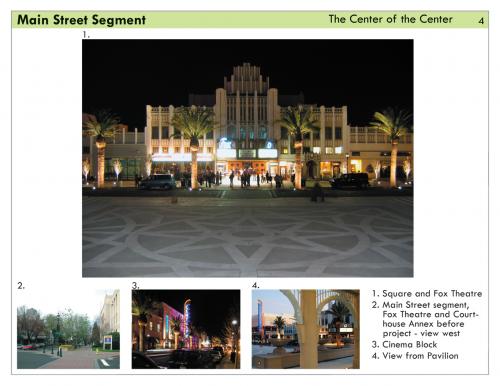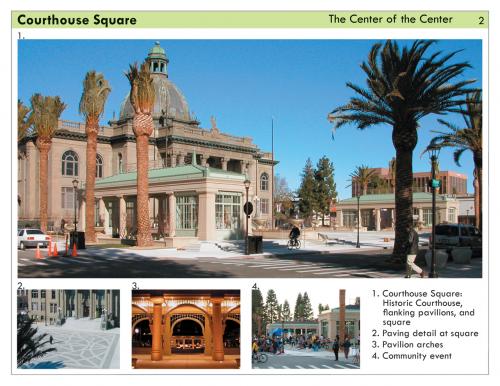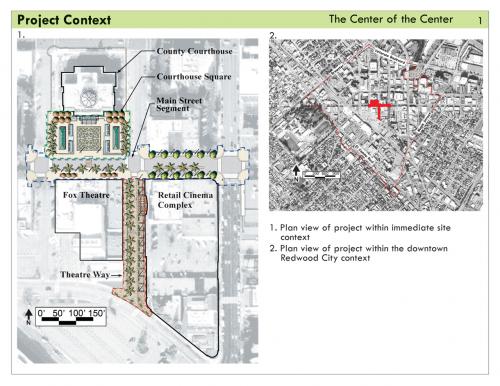
Courthouse Square, Theatre Way and Broadway Streetscape
Location: Redwood City, CA. Struggling downtown in sprawling medium-sized Silicon Valley city
As in many once thriving small and medium-sized American cities, Redwood City, California suffered serious losses in the last 50 years as sprawl in the Silicon Valley has pulled activity away from downtown. Once the largest city between San Francisco and San Jose, Redwood City has in recent decades been nicknamed "Deadwood City" as people went elsewhere to live, work, and play.
Dramatic interventions and civic commitments are now reversing this blow to downtown, and a new urbanist plan is once again reviving the city's center. Several linked public projects are working together to restore the urban pattern and reclaim urban open space. The projects engage the block of the 1910 Beaux-Arts County Courthouse (now functioning as a local history museum), the facing art deco-era Fox Theatre, and an adjoining block with a new mixed use cinema-retail-dining complex. The centerpiece of these efforts is a radical remedy for the 1939 erection of an annex building on the Courthouse's former front lawn, which did double damage - it sheared off and then obscured the grand entrance portico to the Courthouse, and ruptured the traditional relationship of the Courthouse to its fronting attached square. Demolition of the annex and restoration of the portico - a $12 million project - created the opportunity for these new public spaces to heal the historic urban pattern while creating a meaningful setting for contemporary public life.
The submission comprises design and construction of three public realm projects, all conceived through a public workshop process:
1) Courthouse Square: The 1/2 acre square provides a compelling downtown ceremonial and daily gathering space via a plaza that architecturally bridges the neoclassical courthouse and the deco-style Fox Theatre. The square's design sets proper size and proportions for the new downtown gathering place, with two richly-detailed pavilion structures that mediate between the scale of the human form and the monumental courthouse and provide small vendor spaces.
2) The "Theatre Way" outdoor dining street: A row of restaurants at the base of the new cinema fronts on this unique one-block shared use street segment. Restaurants open onto a broad "dining terrace" and sidewalk edged by custom light columns atop a two-step curb that heighten the theatricality of the cinema entrance. Across the street, a row of Canary Island Date Palm trees is set in between angled parking spaces. Space between the buildings can convert in its entirety to a plaza for programmed events, or more typically, can welcome a lively mix of slow-moving traffic, dining, and pedestrian activity.
3) Main Street Segment: This two block re-designed segment now features broad sidewalks, narrow travel lanes, and a continuous colonnade of date palms. At the Cinema block, the formal row of palm trees separate a drop-off lane from primary travel lanes, while at the next block they mark the edge of a wide sidewalk and queuing area in front of the theatre's entrance, a focus of the emerging local live music and performance scene that has been shepherded into existence by a local developer.
The project is one component of a comphrehensive program for downtown revitalization that is being expressed through a Downtown Precise Plan prepared by the project urban designers collaborating with the City Staff that is currently in the public hearing phase. The Precise Plan includes a form-based code as well as re-design of the Downtown Transit Center to include a prominent open space linked to main street. The Code's regulations will safeguard the prominence of the Courthouse as the downtown attracts new higher density residential and office development.
The submitted projects were created as a result of a community process led by the project designers involving a grand array of public, private, and not-for-profit entities. Despite some competing interests of historic preservation, placemaking and business development, the group stayed together during a lengthy community participation, education, and visioning that yielded a shared vision of a stronger downtown. The new public space downtown reflects the people and the places that define the community.
Read more at this project's website.Lessons learned: Historic block and building relationships sometimes trump the value of individual historic structures; Protecting the highest-impact design elements during value engineering is an important job for project advocates; Deliberate programming of ground floor frontage uses and artful design of public spaces are mutually supporting
Transect Zone(s): T5 center, T6 core.
Status: 76-99% Built
Project or Plan's Scale: Street
Features: Civic buildings & parks, Mixed uses.
Total built area (in sq. ft.):
Total project cost (in local currency): 11
Retail area (in sq. ft.):
Office area (in sq. ft.):
Industrial area (in sq. ft.):
Number of hotel units:
Number of residential units (include live/work):
Civic uses (type and size): public square, outdoor dining/gathering area
Parks & green space (in acres): 1
Project team designers: Freedman Tung & Bottomley
Project team developers: City of Redwood City
Previous site status: Redevelopment
Starting/Ending date of construction/implementation: - Present




